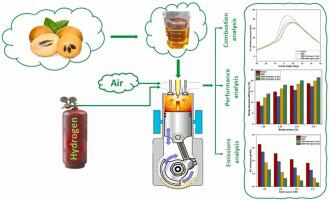该研究旨在研究使用氢气和萨波塔种子生物柴油(SSB) 混合物运行的双燃料模式柴油发动机的特性。在柴油发动机中使用气态氢是提高能源效率和减少排放的实用解决方案。使用萨波塔水果废料种子作为生产生物柴油的新的创新来源已得到认可。值得一提的是,萨波塔种子仅用于播种目的,而不是被认为浪费的目的。对早期研究的全面回顾表明,这项在双燃料运行中除了氢气之外还使用 SSB 混合物的研究是至关重要的。本研究的主要目的是分析单缸柴油发动机 SSB 双燃料模式下氢气的影响。氢气通过进气道燃油喷射器以每分钟 3 升和 6 升 (LPM) 的流速引入进气歧管,并使用 SSB 作为燃料。最大制动功率 (BP) 条件下 3 LPM 和 6 LPM 的氢能份额分别为 16.17% 和 31.07%。结果表明,氢气导入3 LPM和6 LPM使气缸压力分别增加17.26%和21.03%,放热率(HRR)分别增加43.91%和56.13%,制动热效率(BTE)分别增加6.29%和14.62%,制动性能下降。在最大 BP 下,比能耗 (BSEC) 比柴油分别低 21.73% 和 39.13%。此外,氢气 3 LPM 和 6 LPM 将二氧化碳 (CO 2 )、一氧化碳 (CO)、碳氢化合物 (HC) 和烟雾排放量分别减少了 18.61% 和 28.26%、49.68% 和 77.20%、63.01% 和 83.28% 和 23.24最大 BP 时比柴油低 34.63% 和 34.63%。与柴油相比,生物柴油的氮氧化物 (NOx) 排放量增加了 2.84%;然而,当添加氢气时,与最大BP下的柴油相比,NOx排放量增加了9.40%和16.15%。这项研究发现,向 SSB 中添加氢气会增加 BTE,并减少排放,同时略微增加 NOx 排放。这项研究得出的结论是,生物柴油和氢诱导可以替代柴油发动机中的柴油。
 "点击查看英文标题和摘要"
"点击查看英文标题和摘要"
Effect of hydrogen/sapota seed biodiesel as an alternative fuel in a diesel engine using dual-fuel mode
The research aims to investigate the features of a dual-fuel mode diesel engine that runs on hydrogen gas and sapota seed biodiesel (SSB) blend. Using gaseous hydrogen in diesel engines is a practical solution for enhancing energy efficiency and reducing emissions. The use of sapota fruit waste seeds as a new and innovative source to produce biodiesel has been recognized. It is essential to mention that sapota seeds are only used for sowing purposes other than those considered wasteful. A comprehensive review of earlier research indicates that this study, which uses an SSB blend in addition to hydrogen in dual-fuel operation, is essential. The primary objective of this research is to analyze the impact of hydrogen in SSB dual-fuel mode in single-cylinder diesel engines. Hydrogen was introduced into the intake manifold via a port fuel injector at flow rates of 3 and 6 liters per minute (LPM), with SSB as the fuel. The hydrogen energy share for 3 LPM and 6 LPM at maximum brake power (BP) conditions is 16.17% and 31.07%, respectively. The results revealed that hydrogen induction 3 LPM and 6 LPM increased cylinder pressure by 17.26% and 21.03%, heat release rate (HRR) by 43.91% and 56.13%, brake thermal efficiency (BTE) by 6.29% and 14.62%, and decreased brake specific energy consumption (BSEC) by 21.73% and 39.13% than diesel at maximum BP. Moreover, hydrogen 3 LPM and 6 LPM reduced carbon dioxide (CO2), carbon monoxide (CO), hydrocarbon (HC), and smoke emissions by 18.61% and 28.26%, 49.68% and 77.20%, 63.01% and 83.28% and 23.24% and 34.63% than diesel at maximum BP. Oxides of nitrogen (NOx) emissions were increased by 2.84% in biodiesel when compared to diesel; however, when hydrogen was added, NOx emissions increased by 9.40% and 16.15% compared to diesel at maximum BP. This study found that adding hydrogen to SSB increased BTE and decreased emissions with slightly increased NOx emissions. This research concluded that biodiesel and hydrogen induction can substitute diesel fuel in diesel engines.

















































 京公网安备 11010802027423号
京公网安备 11010802027423号